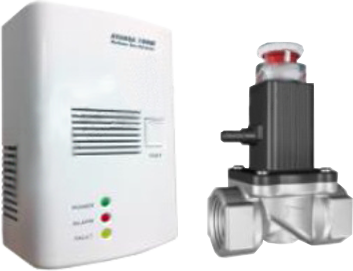Detectors AVANSA
Gas detectors
Accumulation of gas in enclosed spaces (shops, offices, flats, warehouses, garages) can have serious consequences. Installing gas detectors can prevent poisoning, suffocation, fire or explosion. Depending on the type of detector, it can detect the accumulation of methane, butane or propane gas before they endanger your life or property. Detection is local and visual and sound. If the dector is connected to a gas solenoid valve, you can turn it off in case of gas leakage.
- 1 - Green LED (Power) indicates that the detector is operating
- 2 - Red LED (Alarm) signals gas detection
- 3 - Yellow LED (Chyba) indicates operating errors
- 4 - Test button, press this button to test the correct sound alarm function. If you want to test the valve closure, you must activate this function by following the procedure below. Just press the TEST button when the detector is not connected to the mains. Hold the button and turn the detector cable into the electrical socket. Release the button. Wait until the LED flashes. Now you can close the valve by hanging the TEST button.

Mounting
The detector should be mounted on a wall 30 cm below the ceiling where it is designed to detect leakage of methane. Natural gas (methane) is lighter than air and accumulates at the top of the room.
For detection of LPG (butane, propane), the detector is mounted on a wall about 30 cm from the floor. LPG is heavier than air and accumulates at the bottom of the room.


Avansa 100M
- Supply voltage: AC 220V 50Hz
- Sensitivity: 10% L.E.L. (lower explosive limit)
- Response time: <30 s
- Energy consumption: in normal operating mode <1,5 W - alarm 3 W
- Operating temperature: -15°C - 50°C
- Humidity: <97% RH (relative humidity)
- Notification volume: >90 dB (decibels) at a distance of 1 meter from the detector
- Connection dimensions: 1
- Connection to 12V DC solenoid valve
- Polarity: white conductor (+) positive, black lead (-) negative
- Weight: 250 g
- Detectable gases: natural gas (methane), LPG (butane, propane)
- Purchase

Avansa 100M + solenoid valve
Technical parameters of the detector
- Supply voltage: AC 220V 50Hz
- Sensitivity: 10% L.E.L. (lower explosive limit)
- Response time: <30 s
- Energy consumption: in normal operating mode <1,5 W - alarm 3 W
- Operating temperature: -15°C - 50°C
- Humidity: <97% RH (relative humidity)
- Notification volume: >90 dB (decibels) at a distance of 1 meter from the detector
- Connection dimensions: 1
- Connection to 12V DC solenoid valve
- Polarity: white conductor (+) positive, black lead (-) negative
- Weight: 250 g
- Detectable gases: natural gas (methane), LPG (butane, propane)
Technical parameters of the valve
- Types of gas: natural gas (methane) and LPG (butane, propane)
- Solenoid body: brass alloy, nickel
- Sealing material: gum NBR/EKM
- Operating temperature: -10 °C - + 50°C
- Connections: G1/2" DN15, G3/4" DN20, G1" DN25
- Opening: manually
- Closure - 9 V DC - 12 V voltage but manual
- Closing current: >1,5 A (impulz)
- Shutter time: >1s
- Polarity: white wire ä +) positive, black wire (-) negative
- Maximum pressure: 500 mBar (max. 1 bar pressure test for 20 minutes)
- Purchase
Do not install the detector:
- - to places covered with furniture, curtains or other obstacles!
- - in rooms with ventilated air!
- - in places with high humidity!
- - in soldering sites!
- - in places with excessive dust!
- - in areas less than 1.5 meters from heating systems, furnaces and fireplaces!
- Do not install the detector!
- Steam and condensation can damage the detector.
Connection to solenoid valve (12v DC)
The connection to the solenoid valve is carried out via the connection cable supplied with the detector, the white conductor (+) positive and black (-) are negative, while observing the polarity. If the length is not sufficient, the cables may be elongated, but the total length of the cable from the diaphragm valve to the detector should not exceed 20 meters. Also, the color and polarity of the fiber must be respected. Incorrect polarity will damage the solenoid. The detector is powered by 220V AC, 50Hz. When connected to power, the detector will beep. The detector needs a short time to stabilize. Stabilization can take from 3 minutes to a minute; represents the time required for the gas sensor to enter normal operation. During this time the LEDs flash. When the LED flashes, the detector switches to normal operation, the green LED will remain on continuously, indicating that the detector is powered. As long as the green LED lights up, you can be sure the detector works. For optimal operation, the detector should be cleaned once a month by dust drafting inside. Do not open the detector when vacuuming. Only vacuum the detector vents. Do not touch the appliance with a vacuum cleaner hose, just vacuum it carefully. Test the operation every month by pressing the test button or via the ventilation slots at the bottom of the detector to release the gas released from the lighter. The technology of Japanese gas sensors is of superior quality. The detector has a sensitivity of 10% L.E.L (Lower Explosivity Limit), that is, the detector detects the presence of gas and signals when the gas concentration reaches 10% of the Minimum Explosive Concentration (LEL). The lower explosion limit is the minimum fuel concentration in the fuel mixture and the oxidant, from which the explosion can propagate autonomously from the local site. When the detector becomes aware of the presence of gases, it emits a sound alarm and signals the closing of the solenoid valve. The red LED will blink and the detector will be intermittently beepped.
What to do when an alarm sounds?
Do not use any switches! Open the doors and windows to ventilate the room, close all gas valves and leave the room immediately! Do not use electric fans or turn on other appliances that use electricity. Avoid any sparks. Contact your local plumber distribution company! Do not use any phone in the area, because any spark can cause fire or even explosion. Do not run into space until it is fully ventilated and the leak is not discovered and repaired! Consider all gas detector alarms as real until you check for any possible gas leakage. The gas detector does not replace insurance against loss of property, goods or any other health or life insurance. The insurance cover rests solely on your insurance. The detector does not exclude your obligation to safely use and maintain in good working order all installations and equipment that operate on gas. These must be regularly checked by authorized persons. The detector reduces the number of accidents caused by gas leakage. The detector is not a perfect device, any electronic device has certain limits and is not always able to detect the presence of gas in any circumstances. If the power failure occurs, the detector does not work.
The detector may not work due to power supply faults. The detector can not detect the gas leak caused at another level of the house. It can only detect leaks in the room where it is installed. The detector must therefore be installed on every floor of the building and every room where gas leakage may occur. The gas detector can not detect the presence of carbon monoxide or smoke. Use a carbon monoxide detector or a smoke detector. The gas detector indicates even the presence of gas near the sensor. The gas can also be present in the bulk of the house, and the closed door can prevent the gas from reaching the detector.
Carbon monoxide detectors
Accumulation of gas in enclosed spaces (shops, offices, flats, warehouses, garages) can have serious consequences. By installing a carbon monoxide detector, it is possible to prevent poisoning or injury. Carbon monoxide (CO) poisoning is caused by inhalation of this toxic gas. Since the gas does not smell, does not irritate and does not stain, the poisoning occurs without feelings. If the victim sleeps, he feels no symptoms and death is very numerous in such situations. The detector can detect the accumulation of carbon monoxide before it threatens your life.
- 1 - LED "Supply voltage" indicates when the detector is operating
- 2 - RED
- detection of carbon monoxide (red color)
- operation error (yellow color)
- calibration or self-cleaning (green color)
- 3 - test button - press this button to test the operation of the alarm lights
- 4 - air penetration slots


Avansa 150MC
- Supply voltage: AC 220V 50Hz
- Sensitivity: 150PPM +- 80 PPM CO
- Launch time: 3 - 5 minutes
- Energy consumption: <3W
- Operating temperature: -10°C - 55°C
- Humidity: <95% (relative humidity)
- Alarm sound level: >85 dB (decibels) at a distance of 1 meter from the detector.
- Purchase
Do not install the detector:
- - in places covered with furniture, curtains or other obstacles!
- - in places with high air circulation, near doors and windows, or where fans are located!
- - in confined places!
- - to places with high humidity!
- The distance from the CO source must be less than 1.5 m
- Do not paint the detector!
- Steam and condensation can damage the detector.
The detector is powered by 220V, 50Hz. A beep sounds when the detector is powered. After the start, the detector needs a short time to stabilize. Stabilization can take 3 to 5 minutes, which is the time required to calibrate the sensor into operating mode. During calibration, the CO light will blink green. The detector then goes into normal operation, and the power indicator remains on continuously, indicating that the detector is powered. Follow this light to make sure the detector works. Regularly test the detector operation by pressing the Test button (3). The CO light blinks red and detects the beeper. When the detector detects the presence of a dangerous carbon monoxide concentration, it triggers the alarm, the CO light blinks red and the detector sounds the alarm sound. The alarm stops when the carbon monoxide concentration drops below the value that is hazardous to health. The detector regularly performs self-cleaning of the sensor. This takes about 30 seconds, the CO indicator lights green. When the self-cleaning is complete, the CO indicator goes off. The detector continuously monitors the correct sensor function when the sensor is faulty, the CO LED is on and the detector sounds a beep. To make sure that this is not just a faulty problem, disconnect the detector from the power supply for a few minutes and then reconnect it to reset and stabilize the sensor. If the fault persists and the CO LED lights up, it means that the sensor is defective. If the detector is still under warranty, contact the store where you purchased it and return the detector for repair.
What to do when an alarm sounds?
Open the doors and the window to turn off the room immediately to switch off any source of fire! Consider all detector alarms as real until you unpolluted the room. The detector should not replace your alertness. Never leave unattended fire in stoves, fireplaces or other sources that can produce carbon monoxide. The detector does not exclude your obligation to safely use and maintain all equipment that can produce carbon monoxide. These must be regularly checked by authorized persons. The detector reduces the number of accidents but it is not the perfect device; any electronic device has certain limits and is not always able to detect the presence of carbon monoxide. If the power failure occurs, the detector does not work.
The alarm may not always be triggered. The detector may not operate due to a power failure. The detector can not detect carbon monoxide at another level of the house. It can only recognize it in the room where it is installed. The detector should therefore be installed on every floor of the building and every room where carbon monoxide concentrations may occur. The carbon monoxide detector can not detect the presence of gas, LPG or smoke. Use a gas detector or smoke detector to do this. The detector only indicates the concentration of carbon monoxide near the sensor, it can be present in other parts of the house, and the closed door can prevent carbon monoxide from reaching the detector. Install enough detectors to compensate for the presence of doors or other obstacles. You do not always hear a triggered alarm even though there is a sound alarm. If the detector is installed outside the bedroom, the alarm may not wake people with deep sleep and people who have taken sleeping or alcohol and drugs, especially when the door is closed to the bedroom. Even those who are alert can not hear an alarm when it is too distant or the sound is weakened by traffic noise, the operation of audio-video systems, air conditioning or other devices. The alarm can not hear the person with hearing loss.





